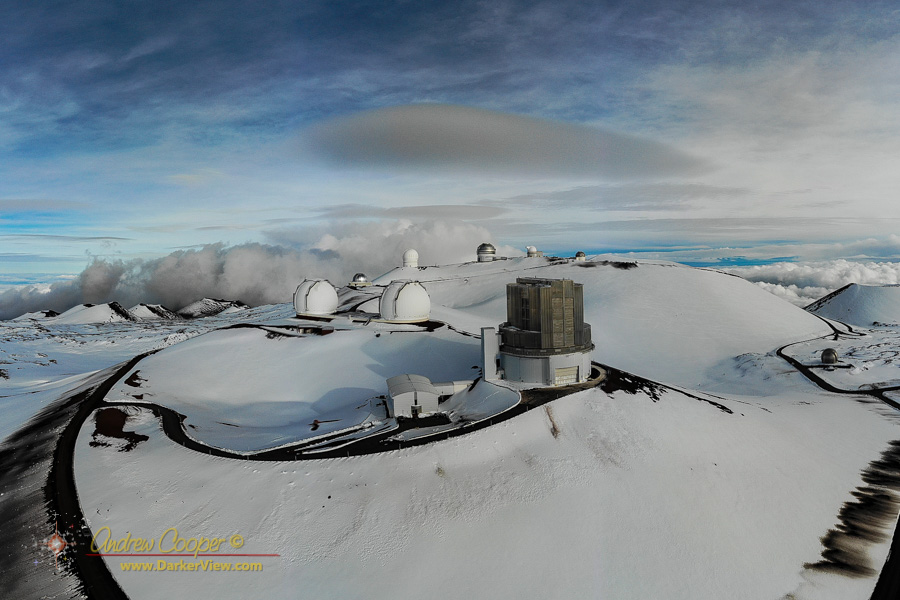
Summit Observatories

When you want to see the stars, find someplace dark

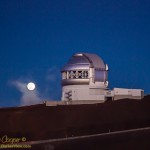
There is a developing maintenance situation at Gemini, a cooling system is failing putting very valuable equipment at risk. To deal with Gemini sought and received permission from both the state and the protesters to send a crew up that mauna to perform emergency maintenance.
Long story short, the protesters failed to honor their agreement today…
At approximately 7:45 a.m. on Tuesday, July 23, a car containing technicians from Gemini Observatory was stopped by activists from entering the Maunakea Access Road. The observatory had been assured access the previous day in conversation with law enforcement, and the Office of Maunakea Management. Despite prior public statements indicating observatory technicians would not be denied access to the telescopes, activists today contradicted their earlier position. Activists told observatory personnel that without a formal, public letter from the observatories – supporting activists’ demands of the state – access for critical technical maintenance is no longer supported.
Official statement from the Maunakea Observatories
Upon initial approach, the car of technicians was initially waived through the bamboo gate; the driver stopped to speak with an official from the Office of Maunakea Management, at which point a kupuna approached the car, stating that access was not to be allowed. Five additional activists then moved to stand in front of the car. This denial of access was contrary to the understanding of access approval by the Gemini crew members and the individual who had initially opened the gate.
The car of technicians respectfully pulled to the side of the road at the request of the activists and waited for approximately 45 minutes. During that time, activist leaders indicated that they were working to determine whether the technicians should be allowed access.
Eventually, the Gemini crew members elected to turn back, given the uncertainty of eventual access. The crew was flagged down on their way away from the access point with an appeal from activists to continue to wait. The crew stopped to speak with the activists briefly before continuing to the Gemini base facility in Hilo.
The Maunakea Observatories continue to support the efforts of state and county law enforcement to restore safe and reliable access to the access road.
About the planned technical work at Gemini Observatory today:
Gemini Observatory uses gaseous helium in a cooling circuit to maintain stable low temperatures for two highly-delicate instruments used in astronomical observations. The cooling system has become unstable, which requires specialized technicians to shut down in order to prevent damage to the instruments and the cooling circuit itself.
The observatory personnel planned to shut off the compressors, move one instrument at risk to a separate cooling circuit, shut down the second, disconnect specific joints in the cooling system, and perform a standard facility inspection that is usually conducted on a daily basis during normal operations. The planned technical work would have taken approximately three hours; the crew would have then come directly back to their Hilo base facility.
On social media the protesters are trying to deny the event, claiming that the state is truly responsible. This is contradicted by the statements of the protest’s official spokesman who put his account of the incident into his daily video report.
In the report Kahoʻokahi Kanuha makes it clear that he was attempting to negotiate with the maintenance crew, asking for a statement supporting the protesters. The crew has no authority to negotiate, no authority to make statements or agreements for others. When this occurred they left as it was clear the protesters had failed to honor their agreements.
Last week I visited Gemini to see their TBAD installation. While we were on the dome floor I used Google Photo Sphere to shoot a few full panoramas of the telescope…
W. M. Keck Observatory Press Release…
Three massive volcanic eruptions occurred on Jupiter’s moon Io within a two-week period, leading astronomers to speculate that these presumed rare “outbursts,” which can send material hundreds of miles above the surface, might be much more common than previously thought. The observations were made using the W. M. Keck Observatory and Gemini Observatory, both near the summit of Mauna Kea, Hawaii.
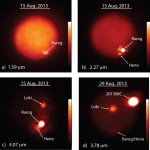
Io, the innermost of Jupiter’s four large “Galilean” moons, is about 2,300 miles across, and, aside from Earth, is the only known place in the solar system with volcanoes erupting extremely hot lava like that seen on Earth. Because of Io’s low gravity, large volcanic eruptions produce an umbrella of debris that rises high into space.
De Pater’s long-time colleague and coauthor Ashley Davies, a volcanologist with NASA’s Jet Propulsion Laboratory at the California Institute of Technology in Pasadena, Calif., said that the recent eruptions resemble past events that spewed tens of cubic miles of lava over hundreds of square miles in a short period of time.
“These new events are in a relatively rare class of eruptions on Io because of their size and astonishingly high thermal emission,” he said. “The amount of energy being emitted by these eruptions implies lava fountains gushing out of fissures at a very large volume per second, forming lava flows that quickly spread over the surface of Io.”
All three events, including the largest, most powerful eruption of the trio on 29 Aug. 2013, were likely characterized by “curtains of fire,” as lava blasted out of fissures perhaps several miles long.
Continue reading “Observations Reveal Massive Eruptions on Jupiter’s Moon Io”
Another great video from my friend Dan Birchall. There are more opportunities to see multiple lasers on the galactic center in coming months. I hope to get up and do some more shooting of my own.
I am truly jealous! My friend Dan Birchall got the photo I had hoped to get… All four Mauna Kea lasers in operation at the same moment. Better yet, all four lasers were on the same target, the center of our Milky Way galaxy. The result is a great photo of four yellew beams converging to the same spot in the sky.
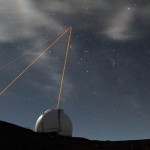
The four beams come from our two Keck telescopes, plus one from Gemini and one from Subaru. the lasers are used to create reference beacons for the adaptive optics systems used on these large telescopes. I will, with a little possessive pride, point out that the Keck lasers are much more powerful than the others.
The scheduling of all four lasers at once is a rare occurrence. All four lasers on the same target? Even more luck was involved! It helps that Dan is a telescope operator and spends far more dark time on the summit than most of us. He took advantage of the situation correctly… Grabbing the camera and shooting.
Below is more footage from Dan, a little time lapse of the telescopes working…
The first Earth-sized exoplanet orbiting within the habitable zone of another star has been confirmed by observations with both the W. M. Keck Observatory and the Gemini Observatory. The initial discovery, made by the Kepler Space Telescope, is one of a handful of smaller planets found by Kepler and verified using large ground-based telescopes.
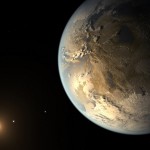
Steve Howell, Kepler’s Project Scientist and a co-author on the paper, adds that neither Kepler (nor any telescope) is currently able to directly spot an exoplanet of this size and proximity to its host star. “However, what we can do is eliminate essentially all other possibilities so that the validity of these planets is really the only viable option.”
With such a small host star, the team employed a technique that eliminated the possibility that either a background star or a stellar companion could be mimicking what Kepler detected. To do this, the team obtained extremely high spatial resolution observations from the eight-meter Gemini North telescope on Mauna Kea in Hawai`i using a technique called speckle imaging, as well as adaptive optics (AO) observations from the ten-meter Keck II telescope, Gemini’s neighbor on Mauna Kea. Together, these data allowed the team to rule out sources close enough to the star’s line-of-sight to confound the Kepler evidence, and conclude that Kepler’s detected signal has to be from a small planet transiting its host star.